Lijiang
|
Lijiang
|
| It is more than 600 kilometres' drive across mountains and rivers northwestern from Kunming to Lijiang, a secluded and quiet place in the east section of the Hengduan Mountains. The area around the ancient town of Lijiang is a wonderful place to escape from the urban jungle. |
|
|
|
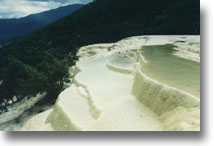 |
Lijiang, the district's government seat, is an old city in beautiful surroundings in northwest Yunnan. It is situated on a plateau at an elevation of 2,600m and is impressive because of its scenery and lush vegetation.
|
|
Lijiang Town is officially called "Dayan Town"-- "Dayan" literally means a "great inkstab", a graphic description of the town's location on a piece of rich flatland fed by a river and surrounded by green mountains. There is no other town in China like Dayan which incorporates the folkways of so many people and the architectural styles of both north and south China. Some say that Lijiang is not unique just because it is unique in too many ways-- how true this is. In December 1986, the State Council designated the place as a famous ancient historical and cultural city of a national caliber. In 1997, the UNESCO put Lijiang on a list of the world's major cultural heritages. |
| The air antiquity assumed by the town testifies to the wisdom of the Naxi people in building it here, not elsewhere. The town is on flatland about 2,400 meters above sea level. To its north are Mt. Xiangshan and Mt.Jinhong and to its west, Mt. Shizi, which effectively shield the town from winter winds. For miles upon miles, cropland expands to the southeast, where the sunshine is abundant and the climate, mild, characterized by breezes blown from the south that cools the summer heat in June and July. It is this area that the local people have turned into a "granary". | 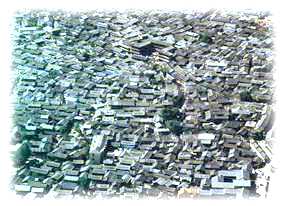 |
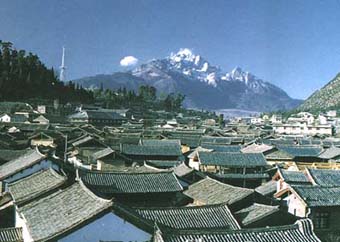 |
What is especially interesting is the way people use water from the Jade Springs. The flow is diverged into the city through three channels. Taking a stroll in the town, you find water your constant companion, flowing merrily either in a stream at your side or in tunnels beneath your foot. To the human race, water means life. To Dayan town, however, it brings not only life, but also beauty. Unlike those asphalted roads in big cities which are straight, streets here wind naturally along streams and around hills. On the West River in the town, there is a sluice-gate which, when lifted, allows water to pour into the city for street washing. |
The Yulong Mountains are located where the Qinghai-Tibet and Yunnan-Guizhou plateaus interlock, and together they form the peak of the Yunling Mountains-- the southern-most section of the Himalaya Mountain range. Harboring a string of marine glaciers, the Yunlong mountain range, with snow accumulated over ages, extends unbroken for 35 kilometers, forming the "Jade Dragon" dancing in clouds. Its silvery "scales" shining bright, the "dragon" has a proudly erect "head" in the far north, while its other parts, rolling south, look like the back of the "dragon." The southernmost peak, rising 5,596 meters above sea level, is also known as the "jade pillar that props up the sky."
|
|
|
| Earthen and wooden housing structures are most popular. A typical courtyard here resembles what is found in Beijing-- walled and in neat squares, with the principle rooms facing south. Unlike the Beijing courtyard which has rooms facing east and west, spacious corridors line both sides of the Nazi courtyard which also has an imposing arch over the gateway. Bridges are seen everywhere, linking streets and lanes. |
|
|
Many were built during the Ming and Qing period from the 14th to the early 20th centuries which have survived the wars and earthquakes. For all this, the town is known as the "Venice of China" or the "Suzhou on the plateau." |
|
| The Children of the land of flowers, the Naxis are fond of flowers and almost every courtyard is a garden. Moreover, every Naxi courtyard is built at the side of a ditch with willow trees growing on both sides. Unwritten but rigorous rules, called "sanyanjing" or "three-hole wells," are followed with regard to use of water. Water in the uppermost "hole" or upper-most section of the ditch is meant exclusively for drinking; the next lower section is where people wash rice and vegetables for cooking; and washing of clothes is allowed only in the lower-most section of the ditch. |
|
 |
The history of the town dates back to the South Song period (1127-1279). In 1253, Kublai, in his expedition to conquer the state of dali, came to what is now Lijiang after his troops crossed the Jinsha river by using inflated bags of animal hide. That explains why many names of places in the Naxi languages are transliterations of "army camps," "drilling grounds," etc. for the Mongolian language. |
|
In the early years of the Yuan Dynasty (1271-1368), there were about 1,000 families in Lijiang, which constantly grew in size during the Ming-Qing period. The heart of the Dayan Town is called "Square Street" - a six "mu" (15 "mu" in one nectare) business center which serves as a hub of communication to Sichuan Tibet and other parts of Yunnan.
| In the early years of the Yuan Dynasty (1271-1368), there were about 1,000 families in Lijiang, which constantly grew in size during the Ming-Qing period. The heart of the Dayan Town is called "Square Street" - a six "mu" (15 "mu" in one nectare) business center which serves as a hub of communication to Sichuan Tibet and other parts of Yunnan. |
|
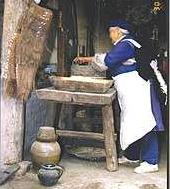 |
Since the Qing period, the town, itself a major producer of handicraft articles, has been the distribution center for goods produced in northwest Yunnan, hence the word "gong ben" in the Naxi language which means "a place with many warehouses." | 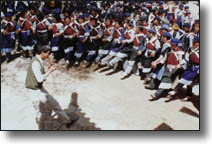 |
| Tibetans send their woolen textiles and medicinal herbs here for shipment to other parts of China, and tea and articles for daily use from Xishuang Banna, Fengqing and Xiaguan of Yunnan are sold to Tibetan areas via the town.By taking advantage of its geographic location, the town has served as a center of economic and cultural exchanges between people of the Tibetan, Han, Bai and Naxi ethnic groups and, moreover, as a shining example of their solidarity. |
| The people of Naxi, while developing their land of snow-clad mountains and turbulent rivers since ancient times, have to their credit the "Dong Ba Culture" seen as one of the world wonders, a culture all-embracing while unique. It refers to the ancient Naxi culture, which is given the name passed down by "dongbas". Dongba Culture originated from the Primary Naxi Religion, and believes in the super natural gods and their rule over the world. It is polytheism and incorporates Lamaism, Buddhism and Daoism. Dongba shaman, which means "wise man", is a witch doctor, scholar, craftsman as well as an artist. Dongbas are disseminators of the Dongba Culture. |
|
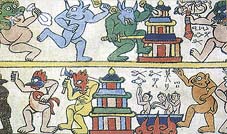 |
The Dongba scriptures are a series of more than 20,000 books written in Naxi pictographs with more than 2000 hieroglyphs, a form of writing invented by the Naxi people more than a thousand years ago. It is reputed as the encyclopedia of the ancient times of the Naxi Nationality. | 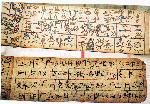 |
The "Dongba Scroll Painting" and the "Art of Dongba Painting" are invaluable treasures in the ethnic gallery. Since the early 1960s, some 20,000 volumes of Dongba documents have been collected and preserved. So far, l,500 volumes have been translated by the Dongba Research Center in Dayan. An important source of history, language, social and religious customs of the Naxi people, and some of them have been published. And in recent years more and more domestic and foreign scholars have come to Dayan to do research work on Dongba culture.
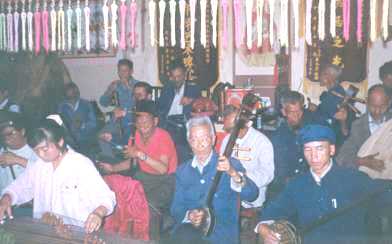 |
Ancient Naxi music is an interesting of the blending of the blending of the Han and Naxi cultures. Their music can be categorised into two parts: White Sand Refined Tunes, ancient Naxi folk music created 700 years ago, and Dongjing Tunes, a blend of Naxi music and Han music, introduced during the Ming and Qing dynasties. Some Han tunes vanished from the Central Plains have been preserved by the Naxis and are now serving as the "living fossils of ancient Chinese music". |
There are many veteran folk musicians in Dayan Town and the Ancient Naxi Music Band has been set up. One of the most famous folk musicians is Mr. Xuan Ke. Mr. Xuan organized a group and gives performance in the town.
 |
As for the scenic spots in Lijiang, besides the so-called “Square Market” in Dayan Town, many other places are worth visiting. The nearest place is Black Dragon Pool, the Yuquan (Jade Spring) Park at the foot of the Xiangshan Mountain north of the city of Lijiang derives its name from the pool, which is as sparkling as jade and as clear as spring water. The entire park, tucked away in the shades of swaying willow trees, is covered with green grass. Under the Shuocui Bridge a waterfall creates a constant roar as it cascades down the stream. | |
|
|
||
| Fifteen kilometres from the ancient city of Lijiang stands the Yulong
Xueshan (Snow Mountain in the image of a Jade - Carved Dragon), a modern
maritime glacier in the southernmost of northern latitudes. Shanzidou, the
main peak of the mountain, looks like a gigantic dragon, clad in white
snow all the year round at an altitude of 5,596 metres above sea level.
Access to the top of the mountain is provided by a cableway from the foot
of the mountain to Yunshanping ( Dragon Spruce Meadow ). Two cableways for
skiers are under construction. |
 |
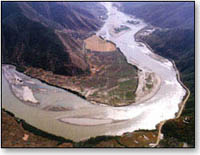 |
Shigu (Stone Drum ) is a town of the Lijiang Naxi Autonomous County which is situated 70 kilometres from the seat of Lijiang County. It is where the Yangtze River, following a northwest course, plunges head - on into a high and cragged cliff, takes a sharp U-turn - believed to be the river's first bend as it flows on - and changes its course in a northeast direction. |
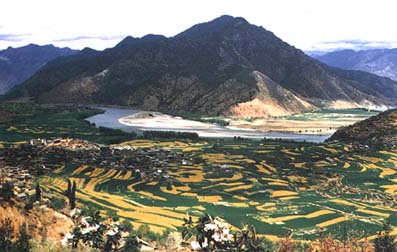 |
Stone Drum |
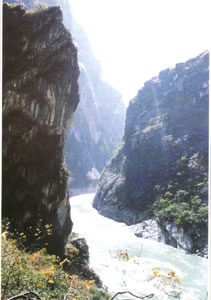 |
Hutiao ( tiger leaping ) Gorge Extending for 15 kilometres from the Yulong Xueshan Mountain in Lijiang to the Haba Xueshan Mountain in Zhongdian. Tiger Leaping Gorge is one the longest, deepest and narrowest gorges in the world. According to local legend, the gorge acquired its name because at its narrowest point, a mere 30 meters wide, a tiger leaped over its swirling waters. | |
|
|
|
|
| The Lugu Lake is set in a dense forest between the Ninglang Yi Autonomous County of Yunnan Province and Yanyuan County of Sichuan Province and 300 kilometres from Dayan Town of Liliang. The environment around the lake is well preserved where the air is fresh, the water pollution-free, and the scenery incredibly delightful. The shore of the lake is home to the Musuo people, a branch of the ethnic Naxi group who retain the vestiges of a matriarchal society. |
|
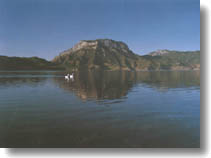 |
 |
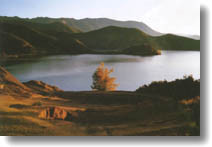 |
| Apart from its mesmerising scenery, the exotic folklore of the local people lends the lake a mysterious air. The lake's shores re home to the ethnic Mosuo people, who are still living under matriarchy. A typical Mosuo family is composed of a dozen or so individuals, all descendants of one ancestral mother. Each family is led by the grandmother of the oldest generation, and a capable female member, who also controls the family purse, runs daily life. The uncles are in charge of production and also take care of the children born by the females out of their "visiting marriage". |
 |
The marriage of the Mosuo people is uniquely romantic. A man and a woman may get to know each other through work or during festivals or rural fairs. When they become intimate, the man will visit the woman and stay for the night, but leaves the next morning, making sure that nobody sees him. The Mosuo people, though, do not regard this relationship, as marriage. If the woman gets pregnant through this relationship, the future child belongs to her and the child has no idea that the father is. |
This unique marriage system gives rise to unique traditions among the Mosuos. All members share the possessions in the family; family property is inherited along the maternal line. When the matriarch grows too old to manage the family, she will choose a wise, capable, amicable, and sociable female member from among the sisters as her successor. The Mosuos take great pride in bearing a daughter; a daughterless family means the lineage is in danger, and girl has to be adopted. This "visiting marriage" system prompted scholars to term the Mosuo people the "last domain of the matriarchy society in the world". A visit to the Lugu Lake convinces one that the "women's kingdom" described in the Chinese classic Journey to the West is not a far-fetched tale but a solid reality.
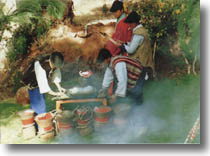 |
|
 |